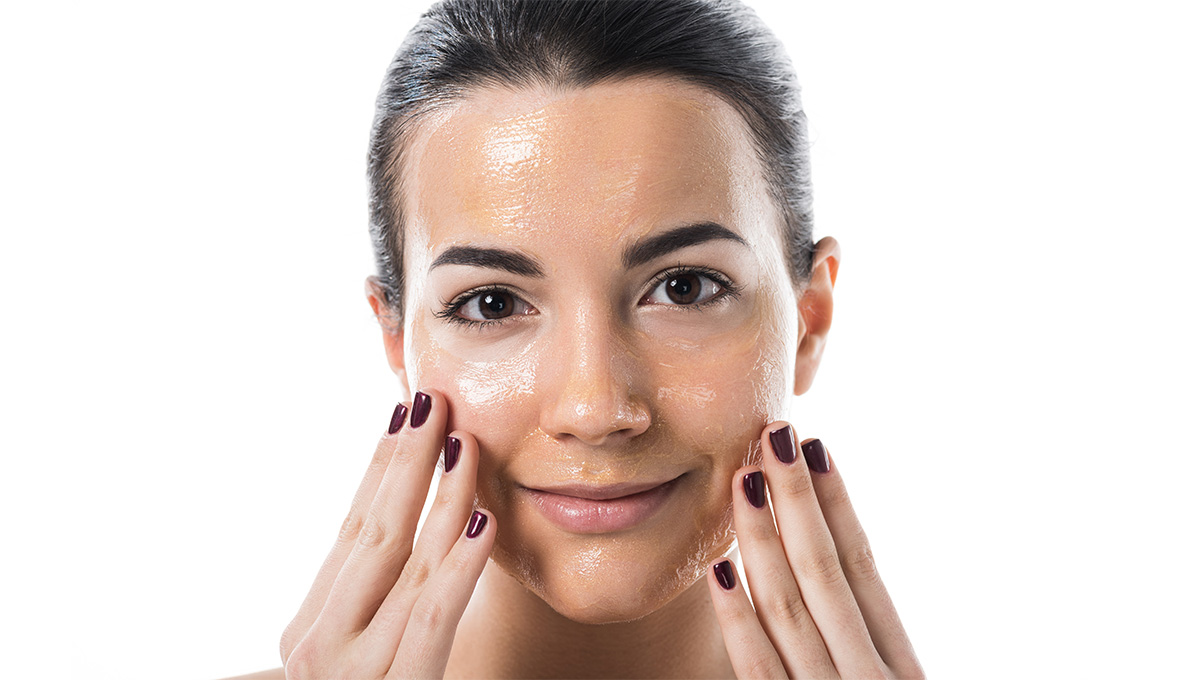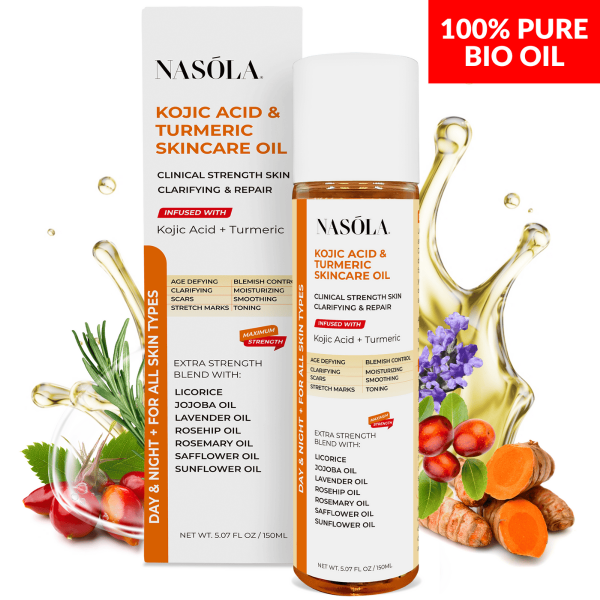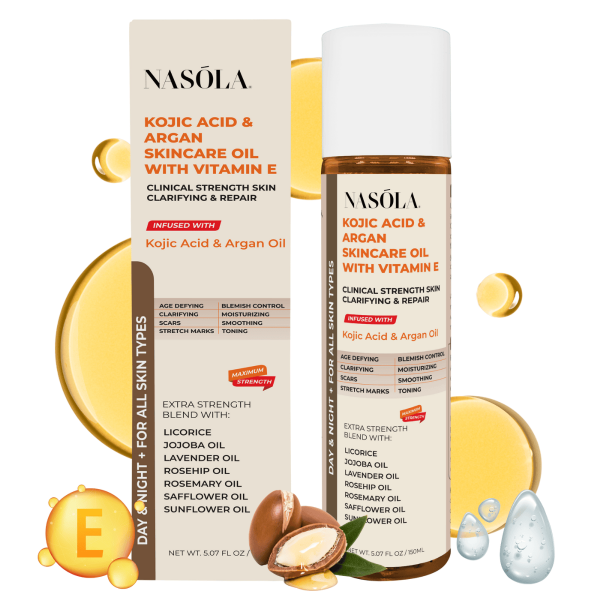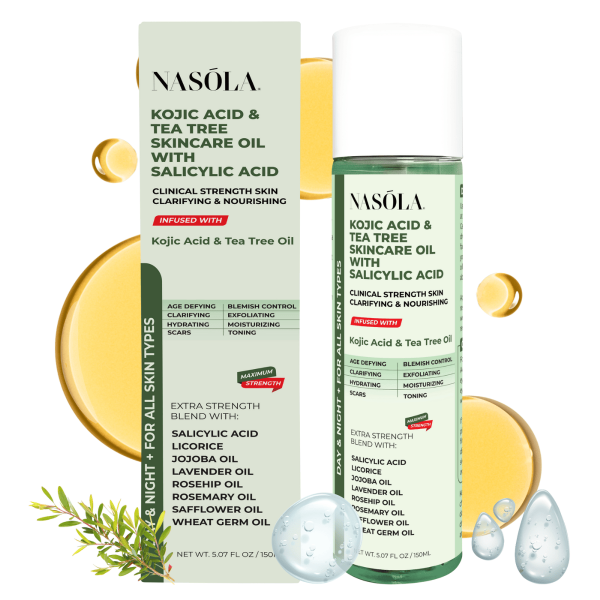Every once in a while, we’ll stare at our bathroom mirror under the harsh honesty of vanity lighting and just know—my skin needs help. Not more makeup. Not more moisturizer. Real help. That’s where dermaplaning oil quietly steps in as the hero nobody saw coming.
It’s amazing how something so simple can flip your whole glow game. Dermaplaning removes peach fuzz and dead skin, yes—but the magic?
That’s all in the oil.
Choose the wrong one, and you could end up irritated or patchy. Choose the right one, your face says “thank you” instantly.
Today, you’ll discover why the right dermaplaning oil matters so much—especially if you’ve got sensitive skin, acne scars, or dullness you’re trying to ditch.
We’ll walk you through what oil to use for dermaplaning at home and why Nasola’s line of specialty oils—the Nasola Kojic Acid Turmeric Bio-Oil, Nasola Tea Tree Bio-Oil with Salicylic Acid, and Nasola Kojic Acid & Argan Bio-Oil—make all the difference.
- Dermaplaning Oil: Why the Right One Matters for Your Skin
- What Oil to Use for Dermaplaning at Home
- Best Oil for Dermaplaning: Top Ingredients to Look For
- Face Oil for Dermaplaning: How to Apply It Correctly
- Best Oil for Dermaplaning Sensitive Skin
- Best Facial Oil for Dermaplaning Based on Skin Concerns
- Ingredient Spotlight: Kojic Acid and How It Transforms Dermaplaning Results
- Conclusion
- Frequently Asked Questions
Dermaplaning Oil: Why the Right One Matters for Your Skin
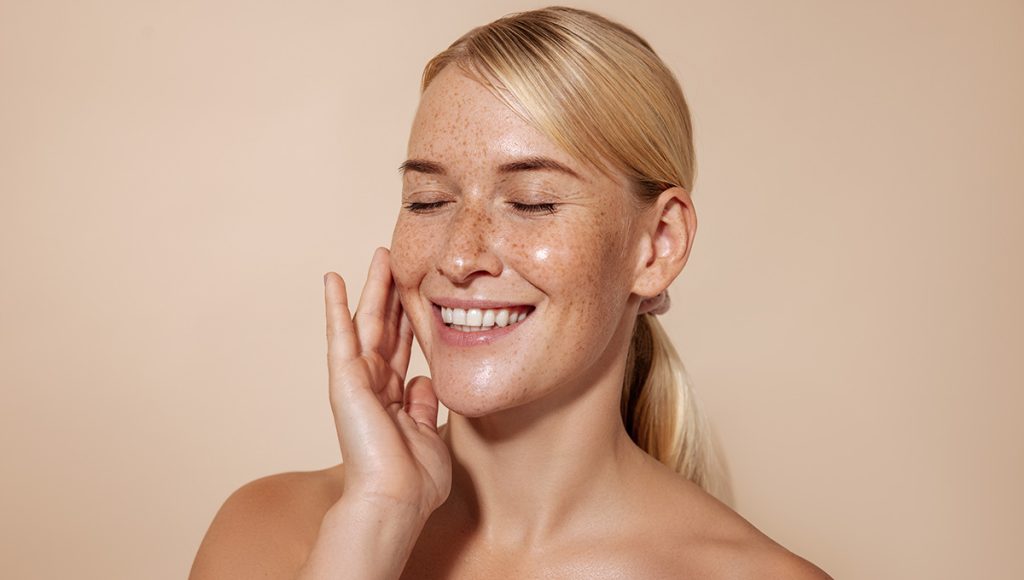
Not all facial oils are made equal—and definitely not when you’re holding a sharp blade to your face (don’t worry, we’re not getting medieval here).
Choosing the best oil for dermaplaning creates the smoothest glide, reduces friction, and protects your skin barrier from micro-tears. No dragging. No redness. Just clean, buttery passes.
The right dermaplaning oil doesn’t just sit there. It enriches your skin mid-exfoliation. We’re talking oils infused with potent ingredients like kojic acid, argan oil, and turmeric that do way more than moisturize—they transform skin by repairing, brightening, and calming down inflammation.
Here’s what makes the right oil stand out:
- Helps the blade glide easily without tugging or snagging
- Infuses skin with restorative ingredients while exfoliating
- Shields sensitive skin from irritation
- Promotes deeper post-treatment penetration of serums
Let’s break it down further…
Benefits of Using Facial Oils During Dermaplaning
So many people overlook this step… and then blame their skin (or blade) when things go wrong.
Using a targeted face oil for dermaplaning isn’t just smart—it’s necessary. Quality oils loaded with antioxidants and hydrators prep your skin to shed dull layers and bounce back with zero drama.
Here’s what a great oil will do:
- Minimize friction so blades glide rather than scrape
- Calm down your skin during exfoliation to reduce redness
- Seal in moisture to avoid dryness hours later
- Deliver treatment-focused ingredients that continue working after dermaplaning
When your skin gets a combo of exfoliation and deep treatment at once? THAT’S when the glow happens.
Why Kojic Acid Boosts Brightening During Dermaplaning
Want brighter, even-toned skin quickly? Kojic acid is your friend.
Dermaplaning already removes dead skin cells. Kojic acid takes it further—treating pigmentation at the root. And with the exfoliation clearing pathways, kojic acid can dive deep into the skin where it makes the biggest impact.
The Nasola Kojic Acid Turmeric Bio-Oil is the MVP here. It’s a blend of kojic acid to fade dark spots and turmeric to tackle redness—perfect for anyone battling hyperpigmentation and post-acne marks. The turmeric calms, while kojic acid lightens, all while your skin is at its most penetrable post-blade.
What Oil to Use for Dermaplaning at Home

Doing dermaplaning yourself? That’s bold—and totally workable when you’ve got the right backup (aka the correct oil).
Picking the best dermaplaning oil depends on more than brand names. It’s about understanding your skin, and then using oils designed with those exact needs in mind.
Save your kitchen oils for cooking—yes, even beloved coconut oil. Many are comedogenic, meaning they clog pores and invite breakouts post-shave. What you need are clean, therapeutic, professional-grade oils.
Some skin types need antibacterial support, while others need moisture cushions. An oil can make or break your at-home session.
- Look for lightweight oils that allow smooth blade glide
- Avoid comedogenic options that can clog freshly-opened pores
- Choose oils with active treatments (like salicylic acid or kojic acid) for multitasking
- Pick soothing ingredients for recovery and glow
Skin Type Considerations
To figure out what oil to use for dermaplaning at home, you need to factor in skin type just as much as goals.
If you’re oily or breakout-prone, you want ingredients that don’t clog or irritate—think tea tree or gentle salicylic acid. If dryness and flakiness are more your issues, ultra-hydrating oils like argan are best.
And if you’re battling tone issues? Let turmeric and kojic acid work their dual magic.
A cheat sheet to help:
- Oily, acne-prone skin → Tea Tree, Salicylic Acid
- Dry, sensitive skin → Argan Oil, Turmeric
- Dull, pigmented skin → Kojic Acid, Turmeric
- Balanced skin types → Lightweight blends with treatment actives
The right match makes all the difference.
Recommended At-Home Dermaplaning Oils
There’s skincare… and then there’s targeted skincare.
The Nasola Kojic Acid Tea Tree Bio-Oil with Salicylic Acid is ideal for those who need exfoliation without the fear of more breakouts. It’s anti-bacterial, thanks to tea tree. Salicylic acid dives deep into pores while kojic acid continues to brighten—long after you’ve wiped the blade.
No fluff. Just clean, glow-enhancing action.
Best Oil for Dermaplaning: Top Ingredients to Look For

Let’s cut to it. If your oil doesn’t contain powerhouse ingredients—what are you even doing?
The best facial oil for dermaplaning should work while you shave and afterwards. Plant-based actives and safe acids can elevate the entire process from “meh” to spa-level results. Think of it as feeding your skin while you exfoliate it.
Key ingredient combos to seek:
- Argan oil: deeply hydrating and non-comedogenic
- Turmeric: battles inflammation, brightens tone
- Kojic acid: treats dark spots effectively
- Tea tree + salicylic acid: blemish-fighting duo
Now—let’s talk details.
Argan Oil
If hydration had a personality, it’d be argan oil.
Rich in essential fatty acids and antioxidants, argan oil is like a cozy, weightless blanket for your skin. It hydrates deep without clogging, making it perfect for post-exfoliation comfort. Sensitive skin? Argan is your trusted companion.
The Nasola Kojic Acid Argan Bio-Oil blends this soothing star with brightening kojic acid to treat while restoring the skin barrier—a double win after dermaplaning.
- Non-greasy moisture
- Protects against environmental stressors
- Nourishes without irritating
- Makes skin supple and luminous
Turmeric + Kojic Acid Combo
There’s a reason turmeric and kojic acid are skincare royalty.
This combo not only soothes inflamed skin but actively works to fade lingering discoloration. Dermaplaning creates the perfect canvas—and this duo paints it beautifully.
With turmeric calming irritation and kojic acid fighting pigmentation, your afterglow looks like you time-traveled back five years. This is what Nasola’s Kojic Acid Turmeric Bio-Oil aims to deliver.
Face Oil for Dermaplaning: How to Apply It Correctly
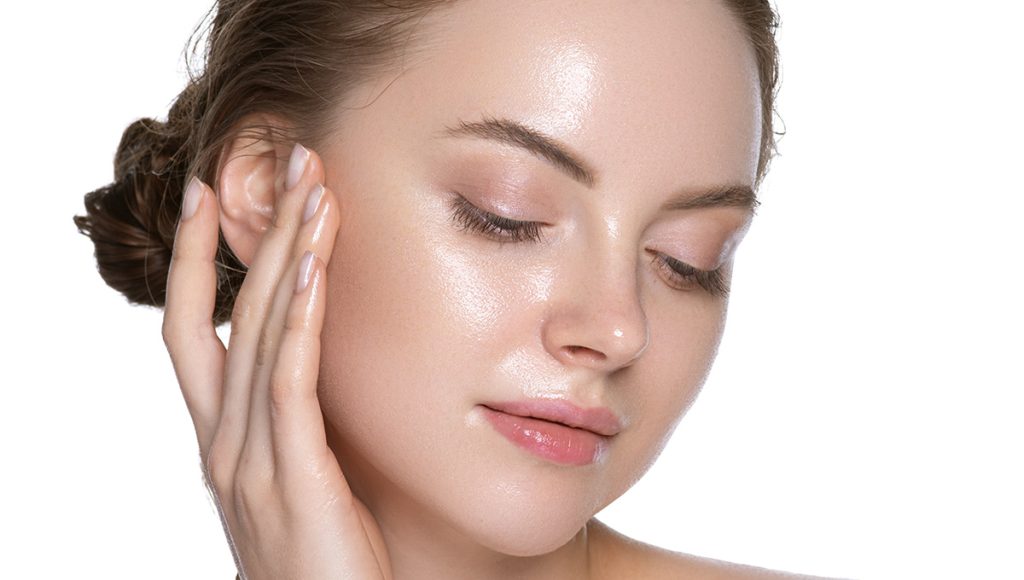
How you apply your oil matters… a lot.
Too much? Slippery mess. Too little? Razor burn. You’ve got to finesse it. Here’s how to use face oil for dermaplaning the right way, for results that flatter instead of frustrate.
This isn’t just skincare. It’s ritual.
STEP 1: Cleanse Thoroughly
Clean skin is non-negotiable. Any oil applied over lingering bacteria or makeup can trap debris—even push it deeper into freshly revealed skin.
Use a gentle, non-stripping cleanser to wash your face. Avoid harsh scrubs, since dermaplaning will provide exfoliation already. When your skin’s clean, pat dry. Not rubbing. Be kind.
Prepping skin this way reduces post-procedure redness and massively lowers breakout risk.
STEP 2: Apply the Oil Lightly
One or two drops is plenty. You’re not deep-frying your face.
Rub a few drops between your fingers. Then apply in upward strokes across your cheek, jaw, nose, and forehead. Don’t go overboard—a thin layer is ideal for optimal blade movement.
Thin layers:
- Prevent blade skipping
- Allow active ingredients to reach the skin evenly
- Avoid product buildup after dermaplaning
STEP 3: Let the Oil Sit a Minute Before Shaving
Here’s where most rush. But this minute? Crucial.
Giving your chosen dermaplaning oil one full minute allows it to soften hair, hydrate the outer layer, and begin infusing active ingredients into the skin. By the time you start shaving, your skin’s saying, “I’m ready.”
Best Oil for Dermaplaning Sensitive Skin

If your skin throws a tantrum after touching the wrong product, this section is for you.
Choosing the best oil for dermaplaning sensitive skin means focusing on minimal ingredients, natural hydrators, and inflammation-style rescue heroes.
Nasola’s formulas are ideal here: lightweight, fragrance-free, and filled with calming botanicals that support the delicate dermis.
Why Sensitive Skin Needs Gentle Yet Effective Oils
Ever finish a facial and feel like you’ve been stung by bees? Ow. That’s your barrier screaming.
Avoid synthetic fragrances, heavy silicones, or alcohol-based oils. Instead, validated ingredients like argan, turmeric, and tea tree offer performance + peace.
Go-to heroes include:
- Argan oil for strengthening
- Turmeric to combat irritation
- Tea tree for gentle acne control
- Kojic acid that brightens without stinging
Recommended Product: Nasola Kojic Acid Argan Bio-Oil
For sensitive types (hi, me), the Nasola Kojic Acid Argan Bio-Oil is the one.
It hydrates dry, reactive skin with argan oil’s featherweight moisture but layers in kojic acid to not forget about fading your dark spots either. A true “best-of-both-worlds” product.
No redness. No flakiness. Just you—glowing.
Best Facial Oil for Dermaplaning Based on Skin Concerns

We all walk around with different goals in mind:
- Clearer pores?
- Fewer dark spots?
- More hydration?
The best dermaplaning oil isn’t one-size-fits-all. So here’s how to match your skin’s demands with Nasola’s targeted solutions.
Brightening and Spot Fading
Use: Nasola Kojic Acid Turmeric Bio-Oil
Why: Fades pigmentation while soothing inflammation. Perfect post-blade when ingredients go deeper.
Clearer Pores + Acne Control
Use: Nasola Kojic Acid Tea Tree Bio-Oil with Salicylic Acid
Why: Tea tree fights bacteria. Salicylic acid unclogs. Kojic acid brightens. Done.
Deep Moisture for Dry Skin
Use: Nasola Kojic Acid Argan Bio-Oil
Why: Argan oil nourishes deeply without irritation. Kojic acid keeps tone even longer term.
Ingredient Spotlight: Kojic Acid and How It Transforms Dermaplaning Results

Introducing the magic ingredient holding down the glow—kojic acid.
Paired with dermaplaning, kojic acid not only penetrates faster but also treats the exact issues exfoliation exposes. It declutters pores, prevents hyperpigmentation rebound, and boosts cellular turnover in the recovery phase.
Benefits of Combining Kojic Acid With Dermaplaning
Combo goals:
- Targets dark spots as skin is freshly exfoliated
- Evens out pigmentation long after one use
- Works deeper and faster thanks to post-blade absorption
- Combats discoloration aggravated by the sun or acne
How Kojic Acid Works Post-Dermaplane
Here’s the quiet superpower: kojic acid keeps doing the work after the facial ends.
As your skin renews post-peel, kojic acid slows melanin production, minimizing chances of new spots forming. And while your dermaplaned skin absorbs everything faster, it’s kojic acid that turns the glow into lasting change.
Say goodbye to dull skin.
Conclusion
Smooth skin isn’t just some unattainable “luxury” anymore. With the right dermaplaning oil, you’re steps away from clarity, softness—and that luminous look that makes makeup optional.
Every Nasola formula helps you achieve it faster, safer, and with enthusiasm.
Each specialized blend merges clinically loved ingredients (like kojic acid, tea tree, argan, and turmeric) designed to help your skin feel like home again. Whether you’re spot-fading, pore-clearing, or just hydrating—there’s a Nasola oil that fits like a glove.
So… ready to shine?
Explore Nasola’s full Bio-Oil collection and transform your skincare from routine into ritual.
Frequently Asked Questions
It depends on your skin type. Oily or acne-prone? Use the Nasola Kojic Acid Tea Tree Bio-Oil with Salicylic Acid. Dry or sensitive skin? The Nasola Kojic Acid Argan Bio-Oil offers hydration and calming benefits without clogging pores.
Not recommended. Coconut oil can clog pores and trigger breakouts. Instead, opt for non-comedogenic oils like the Nasola Kojic Acid Argan Bio-Oil, which hydrates without blocking pores while also brightening your skin.
Yes. It protects your skin during the process, prevents nicks, and allows blades to glide smoothly. Plus, it feeds your skin with beneficial ingredients, making dermaplaning more effective and comfortable.
When formulated properly, no. Nasola oils use kojic acid in skin-safe concentrations, making them gentle enough even for regular use on sensitive skin post-dermaplaning.
Most skin types do well with dermaplaning once every 2–4 weeks. Be sure to follow up with hydrating products like the Nasola Kojic Acid Turmeric Bio-Oil to restore barrier strength and encourage fast healing.
Choose Nasola Kojic Acid Tea Tree Bio-Oil with Salicylic Acid. Tea tree kills bacteria, salicylic acid helps clear blemishes, and kojic acid ensures post-acne marks fade before they even dig in.
Not if it’s non-comedogenic. Nasola’s oils are designed to nourish without clogging—perfect for exfoliated skin that needs clean hydration.
Turmeric is anti-inflammatory and brightens dull skin. Argan oil provides essential hydration and strengthens the skin barrier, perfect for sensitive complexions.
Technically, yes. But it increases your chances of irritation, cuts, and uneven blade movement. Using oil makes the process safer and gives the added benefit of skincare treatment.
Absolutely. Nasola’s oils are cruelty-free and infused with natural, skin-loving ingredients like argan, turmeric, tea tree, and kojic acid. They’re also free from parabens, toxins, and synthetic fragrances.

